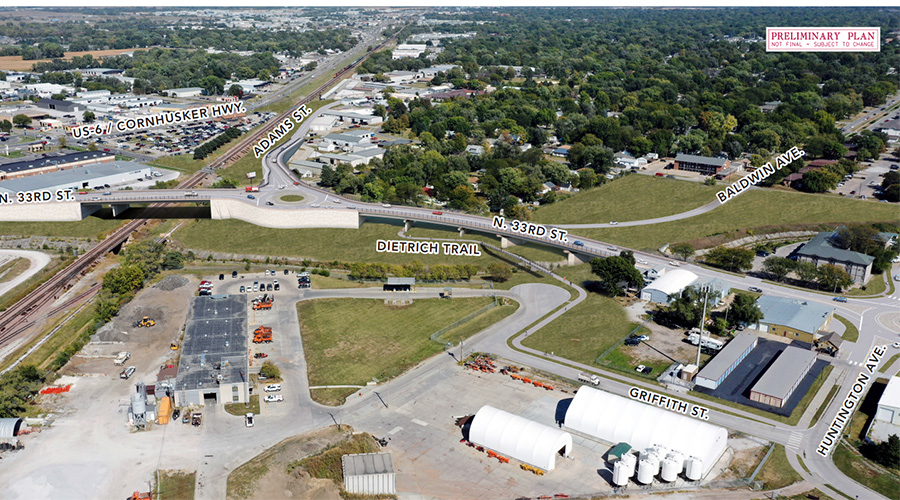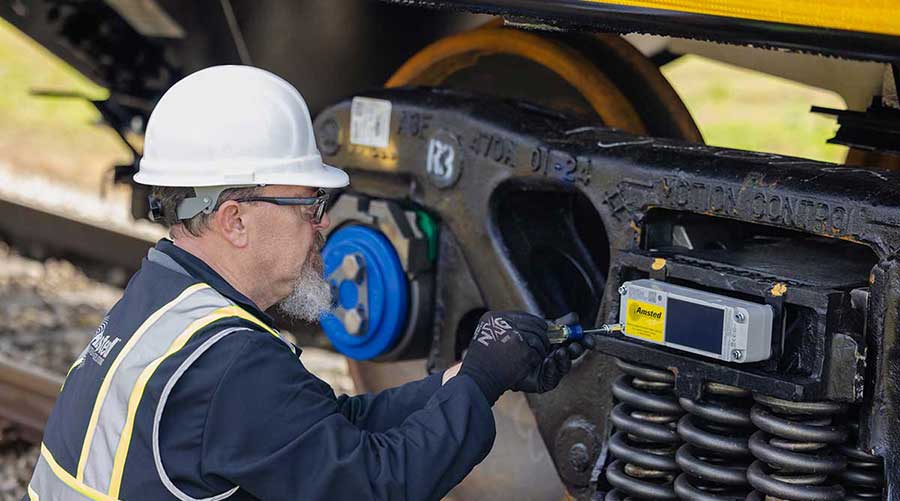Stay updated on news, articles and information for the rail industry
 railPrime
railPrime
July 2015
Rail News: CSX Transportation
Why young professionals plan to keep working on the railroad
By Deborah R. Huso
Elizabeth Hutchison was living in Chicago employed in corporate communications in heavy manufacturing when she learned about an opportunity doing similar work for Union Pacific Railroad. It was a no-brainer for this Millennial to make the move to Omaha as a UP senior communications manager nearly six years ago, but not because she was a native Nebraskan.
“The appeal to me was the opportunity to work for Union Pacific,” she says. “Rail is such a critical industry.”
 Elizabeth Hutchison
Elizabeth HutchisonUnion Pacific Railroad
Hutchison also appreciates the security of working in a 150-year-old industry, as well as the diverse experience it offers.
“You can’t be siloed here,” she explains. “You work with people across the railroad. We’re in 23 states. The big machine that is the rail industry is fascinating.”
Career stability matters. Hutchison’s reasons for not only choosing but staying with a career in rail are echoed by many of her generation working for Class Is in non-agreement positions. Scott St. Clair, manager of strategic planning at Norfolk Southern Corp., came to the railroad five years ago right after graduating from college. He wasn’t recruited — he sought out NS.
“I was familiar with the company growing up. Rail is a strong industry, and it’s really safe," he says. "The railroads felt the effects of the economic downturn, but it’s an industry people rely on.”
In other words, railroads aren’t going anywhere, and neither are Hutchison and St. Clair.
While Generation Xers grew up during a time when company hopping was the norm, Millennials watched their parents struggle through a recession, losing jobs, houses, savings. The result? Even among those working in information technology, the drive to find a solid employer with lots of opportunities for growth within a single company is strong.
Alexandre Brisson, senior director of planning and strategy in CN's IT department, signed on with the railroad in 2003 after serving the road for several years as a consultant.
“I was absolutely amazed by the amount of projects going on and the company’s drive to improve," he says. "And every two years, I’ve had an opportunity for a new job.”
 Alexandre Brisson, CN
Alexandre Brisson, CNOne reason: For the past several years, railroad hiring managers have been on the prowl for new talent. A decade ago, looming retirements, normal attrition and traffic growth at North American railroads prompted H.R. execs to convince management to put talent recruitment and retention at a premium.
“In 2005, 75 percent of our employees were baby boomers,” says Diana Sorfleet, vice president and chief human relations officer at CSX Transportation. “Now, we’re about a third Millennials, a third Gen Xers, and a third baby boomers.”
At the end of 2014, Class Is had 8,000 more employees than a year earlier, and railroads plan to hire another 15,000 this year, according to the Association of American Railroads (AAR). And contrary to popular belief, rail is competing well with other Fortune 500 industries when it comes to compensation and benefits, according to AAR. The average railroad employee’s annual salary is $109,000.
“Railroads have historically hired every 20 to 30 years, but we’re now focused on constantly refreshing our workforce to maintain a balance of age and tenure," says Sorfleet, adding that CSX’s attrition rate the last 10 years has been around 10 percent.
Meanwhile, retention rates are strong. At NS, retention stands at about 90 percent for non-agreement employees who go through the company’s management trainee program, a comprehensive 12-month training that exposes new non-agreement employees to the whole of the railroad while also giving them an opportunity to grow a professional network, says NS Manager of College Recruiting Patrick Rickard.
“We set them up to succeed early in their careers,” he adds. “Colleges are aware of this. And we provide salary and promotions based on performance.”
Kari Damrow saw the opportunity of a similarly viable career path at CSX.
“I had been in IT for 10 years before coming to CSX,” says Damrow, who joined the Class I in 2008 and now serves as technical director. “Primarily I was looking for a company with opportunity for growth and stability.”
 Kari Damrow
Kari DamrowCSX Transportation
Professional development is the ticket. The railroad also met her salary expectation and she's had multiple promotions during her seven-year stint. Early in her CSX career, she benefited from the railroad's Associate Development Program, which paired her with a mentor in sales and marketing who helped her build relationships across departments and the rail system.
“CSX wants employees to get a broad understanding of the company, so they match new hires with mentors from other areas,” Damrow says.
At UP, the one-year retention rate for non-agreement employees consistently has been above 90 percent, says Sherrye Hutcherson, UP's vice president of human resources.
“More than 45 percent of current UP employees have less than 10 years of service,” she adds.
Providing professional development opportunities also is a priority at CN. Employees in transportation receive 11 months of training; in corporate departments, the onboarding program lasts two years, says Senior Manager of Human Resources Susan Ward. New hires also benefit from CN’s buddies program, which matches them with a go-to person to help them grow their network and find resources to do their jobs better.
“We’re known for our professional opportunities,” says Ward, a third-generation railroader. “A lot of people in executive management started young in the company.”
Many of today’s young hires like the idea of doing the same.
“A lot of the people who come to us are looking for stability,” says CN Director of Talent Management Christine Joanis.
And a lot of them find it.
“Retention is really good on the management side,” Joanis says. “On the IT side, we lose less than 5 percent.”
Why might an up-and-coming IT star choose rail rather than head for the Silicon Valley? Joanis has a few ideas.
“When you look at IT, we have 800 to 900 people in that department alone,” she explains. “We have one of the biggest construction companies in Canada. If you work here, you get exposed to a variety of projects, ranging from telecom to infrastructure.”
CN has hired about 15,000 employees in the last five years, most of the hiring driven by retirements and traffic growth, she adds.
“Everything has changed so much,” Joanis says. “When I look at IT 10 years ago, I’d lose two people a year. If we can retain people in IT, we’re doing OK!”
 Scott St. Clair
Scott St. ClairNorfolk Southern Corp.
Railroads ramp up recruiting efforts. Overall, Class I hiring managers believe they're doing better than OK. NS’s Rickard believes the industry's stepped-up recruitment efforts have helped railroads land quality, committed new hires.
At NS, which is "hiring a lot more people" that it was 10 years ago, internship and co-op programs for students or recent grads have helped attract top-notch talent, particularly from the college recruitment circuit, Rickard says. This year, NS will have 250 co-ops and interns who may not realize that NS isn't their grandfather's — or even father's railroad.
“The railroad culture itself has changed,” Rickard says.
So has the mindset of young professionals.
“They saw their parents get burned by the Great Recession," Rickard says. “They aren’t just looking at now. They’re looking at their level of financial stability 30 years out.”
NS's St. Clair, who started his rail career five years ago as a trainmaster, concurs.
“The rail industry is something that can support me and my future family, and let me be innovative with a career I can build on,” he says.
Deborah R. Huso is a Barboursville, Va., freelance writer. Email comments or questions to prograil@tradepress.com.
What else is keeping Millennials onboard?
Stability and career development opportunities rank high on Millennials’ list of what they value in a career on the railroad. What else is getting them to stick around? Railroad H.R. managers and employees weigh in:
• Railroad pensions, matching 401ks, and Railroad Retirement. Railroad employees receive traditional pensions that increasingly fewer companies offer as well as Railroad Retirement RRT in addition to Social Security.
• Performance-based promotions and bonuses. For example, CN offers Performance Share Units, and 40 percent of management employees benefit from them.
• Continuing education. All Class Is offer some type of tuition reimbursement for employees to continue their education. CN paid full tuition for Brisson to get his executive MBA.
• Volunteer opportunities. This is a generation that wants to give back, and they look for companies that are not only philanthropic but that match employee volunteer contributions. Norfolk Southern Corp., for example, has a matching gifts program in which they provide a matching contribution to an eligible nonprofit to which an employee donates up to $35,000/year per employee.
• Free or discounted wellness programs ranging from on-site fitness centers to weight loss programs. Union Pacific Railroad, for example, offers access to 8,000 gyms across the country in addition to its free fitness class at Omaha headquarters.
• On-site child care. For example, Union Pacific offers on-site childcare at its corporate headquarters in Omaha.
— Deborah R. Huso
 Rail-Car Outlook '25: Definitely not 'Back to the Future' anytime soon — forecast by Richard Kloster
Rail-Car Outlook '25: Definitely not 'Back to the Future' anytime soon — forecast by Richard KlosterKeywords
Browse articles on working on the railroad rail recruiting employee retention rail jobs rairoad millennials Union Pacific Norfolk Southern CN CSX railroad ITContact Progressive Railroading editorial staff.


 LRW Honors Amtrak’s Acheson As Railway Woman Of The Year
LRW Honors Amtrak’s Acheson As Railway Woman Of The Year
 From Editor-In-Chief Foran: Of Gender Equity And Inclusion
From Editor-In-Chief Foran: Of Gender Equity And Inclusion
 Spotlight On Some Of Today’s Rail Safety Products
Spotlight On Some Of Today’s Rail Safety Products
 Women of Influence in Rail eBook
Women of Influence in Rail eBook







